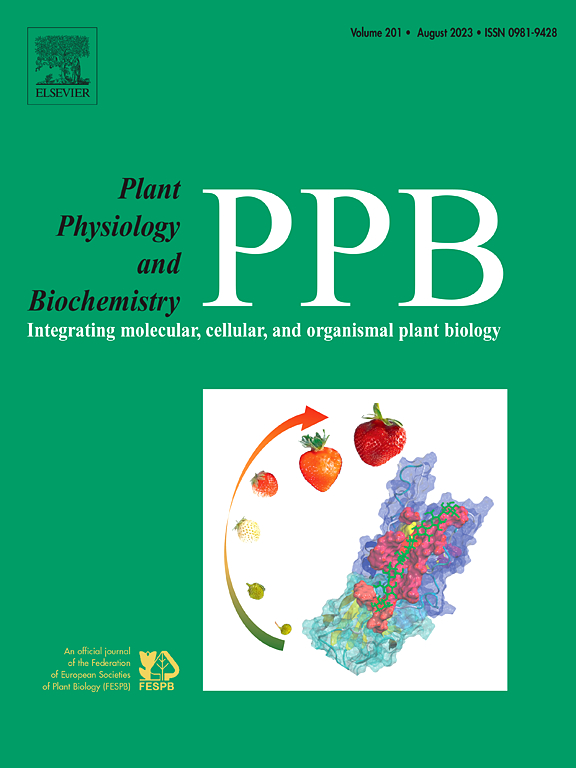新型手性除草剂氟磺胺对刺槐光合作用对映体选择生物活性的干扰
IF 6.1
2区 生物学
Q1 PLANT SCIENCES
引用次数: 0
摘要
氟磺胺是一种新型手性除草剂,具有两种立体异构体形式。其可能的对映选择性作用尚不清楚。R-flusulfinam对大肠杆菌的活性分别是S-flusulfinam和Rac-flusulfinam的7.13倍和1.69倍。r -氟磺胺对十字花菜的光合系统造成损害,导致光合色素沉着水平的破坏。采用液相色谱-串联质谱法对其类胡萝卜素含量进行了系统分析。这在几种类胡萝卜素(包括β-胡萝卜素、α-胡萝卜素和番茄红素)的下降中尤为明显。采用实时荧光定量PCR技术进行基因表达分析。r -氟磺胺处理改变了大肠杆菌光合作用相关基因的表达谱。具体来说,光合反应中心组分编码基因PSAD、PSBS、PETE的表达水平发生了变化。并且观察到参与类胡萝卜素生物合成的基因(包括PSY、PDS和ZDS)的转录显著减少。此外,通过过氧化氢和丙二醛含量测定以及抗氧化酶(SOD、CAT和POD)活性测定,r -氟氟南处理组对大肠杆菌的氧化损伤程度更高。r -氟磺胺通过抑制光合作用和诱导氧化损伤表现出比s -氟磺胺更强的除草活性。这些结果有助于了解氟磺胺对大肠杆菌的潜在对构象选择性机制,并为应用对构象纯度较高的r -氟磺胺来降低除草剂的施用量提供依据。本文章由计算机程序翻译,如有差异,请以英文原文为准。
Enantioselection bioactivity disturbances in the photosynthesis of Echinochloa crus-galli caused by flusulfinam, a novel chiral herbicide
Flusulfinam is a novel chiral herbicide that exists in two stereoisomeric forms. The possible enantioselective effect on Echinochloa crus-galli remains unknown. R-flusulfinam was 7.13 and 1.69 times more active against E. crus-galli than S-flusulfinam and Rac-flusulfinam, respectively. R-flusulfinam caused impairment to the photosynthetic system of E. crus-galli and resulted in the disruption of photosynthetic pigmentation levels. A systematic analysis of the carotenoid fraction content was conducted utilizing liquid chromatography-tandem mass spectrometry. This was particularly noticeable with the decline in several carotenoids, including β-carotene, α-carotene, and lycopene. Furthermore, real-time fluorescence quantitative PCR was employed for gene expression analysis. Treatment with R-flusulfinam altered the gene expression profiles of E. crus-galli related to photosynthesis. Specifically, the expression levels of genes encoding photosynthetic reaction center components, such as PSAD, PSBS, and PETE, were changed. And a significant reduction in the transcription of genes involved in carotenoid biosynthesis, including PSY, PDS, and ZDS, was observed. Furthermore, hydrogen peroxide and malondialdehyde contents were determined as well as antioxidant enzymes (SOD, CAT, and POD) activity assays, R-flusulfinam treatment group exhibited a higher degree of oxidative damage to E. crus-galli. R-flusulfinam demonstrated greater herbicidal activity than S-flusulfinam by substantially inhibiting photosynthesis and inducing oxidative damage. These results contribute to understanding the potential enantioselective mechanisms of flusulfinam against E. crus-galli and provide evidence to support the application of enantiomerically pure R-flusulfinam to reduce the application rate of herbicides.
求助全文
通过发布文献求助,成功后即可免费获取论文全文。
去求助
来源期刊
CiteScore
11.10
自引率
3.10%
发文量
410
审稿时长
33 days
期刊介绍:
Plant Physiology and Biochemistry publishes original theoretical, experimental and technical contributions in the various fields of plant physiology (biochemistry, physiology, structure, genetics, plant-microbe interactions, etc.) at diverse levels of integration (molecular, subcellular, cellular, organ, whole plant, environmental). Opinions expressed in the journal are the sole responsibility of the authors and publication does not imply the editors'' agreement.
Manuscripts describing molecular-genetic and/or gene expression data that are not integrated with biochemical analysis and/or actual measurements of plant physiological processes are not suitable for PPB. Also "Omics" studies (transcriptomics, proteomics, metabolomics, etc.) reporting descriptive analysis without an element of functional validation assays, will not be considered. Similarly, applied agronomic or phytochemical studies that generate no new, fundamental insights in plant physiological and/or biochemical processes are not suitable for publication in PPB.
Plant Physiology and Biochemistry publishes several types of articles: Reviews, Papers and Short Papers. Articles for Reviews are either invited by the editor or proposed by the authors for the editor''s prior agreement. Reviews should not exceed 40 typewritten pages and Short Papers no more than approximately 8 typewritten pages. The fundamental character of Plant Physiology and Biochemistry remains that of a journal for original results.

 求助内容:
求助内容: 应助结果提醒方式:
应助结果提醒方式:


